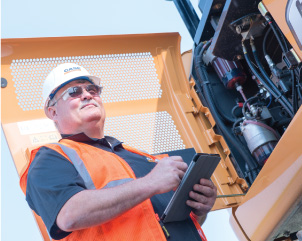How to Improve Sustainability in Construction: Your Equipment Is Key
Construction sustainability is not just a passing fad. It’s fast becoming an important factor in how projects are planned and executed, which machines are selected, and what techniques are used to complete the work. By prioritizing efficiency and environmental responsibility, you not only make your operation more appealing to potential customers, but you can also significantly reduce your costs. For instance, minimizing idle times and unnecessary equipment movement lowers fuel consumption while decreasing your emissions. Similarly, electric equipment generally offers lower fuel and maintenance costs compared to diesel powered alternatives.
Here are the most important strategies for boosting sustainability in construction:
- Prioritize equipment preventive maintenance
- Leverage GPS and smart equipment technology
- Reduce unnecessary idling and equipment movement
- Add electric equipment to your fleet
- Train operators to focus on efficiency
- Take a comprehensive approach
Prioritize equipment preventive maintenance
Effective construction equipment management is key for minimizing its environmental footprint. A proactive maintenance plan helps improve fuel efficiency, cut down on emissions, and extend your machine’s lifespan. Easy things like oil changes, air filter replacements, and engine tune-ups will ensure your equipment performs at its best, reducing fuel consumption but also preventing potential breakdowns that could lead to greater waste and environmental harm.
Leverage GPS and smart equipment technology
Advanced tracking systems, such as telematics, provide real time data on fuel use, machine performance, and location. By integrating these technologies, equipment owners gain valuable insights into fleet efficiency and can pinpoint areas of opportunity. These systems also offer early alerts for maintenance needs, preventing excessive wear and tear, eliminating downtime, and supporting your overall sustainability goals.
Reduce unnecessary idling and equipment movement
Many jobsites end up wasting large amounts of fuel through long periods of idling and inefficient machine placement. Through thoughtful planning of where your equipment will be located, how it will move from on part of the jobsite to another, and establishing clear rules about idling and other operational protocols, you can significantly reduce fuel use and emissions on the job. By introducing more effective construction equipment management, like training operators to be aware of machine positioning, creating a site layout that minimizes movement, and using technology to track and eliminate long idle times, you can boost your construction sustainability.
Add electric equipment to your fleet
As battery technology advances and becomes more affordable, electric construction equipment offers numerous benefits. These machines operate with zero direct emissions, generate less noise, and often require less maintenance than their diesel counterparts. Although upfront costs may be higher, the long term savings on fuel and service, along with a smaller carbon footprint, make them a worthwhile investment. We recommend starting with the areas where electric machines make the most sense for your business, like for urban jobsites and indoor projects.
Train operators to focus on efficiency
A well trained team plays an important role in construction sustainability efforts. Educating operators on fuel efficient driving techniques, proper machine handling, and the impact of their daily decisions can lead to significant savings and reduced environmental impact. Beyond technical skills, fostering a culture of sustainability in construction through ongoing training and performance incentives empowers employees to contribute to more responsible operating practices.
Take a comprehensive approach
Sustainability in construction is not a one size fits all type of solution. It involves a combination of smart strategies and continuous effort, tailored to your specific needs and requirements. By focusing on equipment preventive maintenance, advanced machine technology, better jobsite planning, electric machinery, and operator training, construction companies can minimize their carbon footprint while also lowering costs and maximizing efficiency.
If you have any questions about construction sustainability, equipment preventive maintenance, or construction equipment management in general, please contact our team today!

